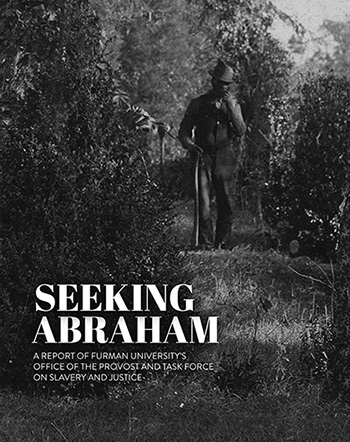MayX Snapshot: Seeking Abraham and finding Furman’s hidden histories
This week, we’re highlighting courses from May Experience – a chance for students to explore topics beyond the typical academic year.
COURSE: Multimodal Interpretive Strategy: Seeking Abraham
INSTRUCTORS: Brandon Inabinet, professor of communication studies; and Alyson Farzad-Phillips, assistant professor of communication studies
DESCRIPTION: This course trained students in counter-memory activism on Furman’s campus. Students learned the Seeking Abraham tour, which shows hidden legacies of race and racism in the campus landscape.
It does not take place overseas, but one MayX course does introduce its students to a land that may suddenly seem foreign to them: their own campus.
The Seeking Abraham tour can make people feel like they’re seeing Furman for the first time, said Brandon Inabinet, who teaches the Multimodal Interpretive Strategy course along with Alyson Farzad-Phillips. The tour visits several campus landmarks, with a guide narrating their “hidden histories” by relating historical facts and anecdotes that reveal their problematic undertones. The tour traces the university’s growth from its pre-Civil War founding through its recent reckoning with its racial legacy and connections to slavery.
“I had so many eye-opening moments throughout these past weeks,” said student Alexandra Bussom ’24. “Before the class, I thought I had decent background knowledge on campus, but over the last three weeks, I have gained an awareness of how the experiences of African Americans have impacted the university to the present day.”
“When we bring to light untold public memories or histories, or when we find new ways of articulating under-told stories, we provide our institutions with an opportunity to check these narratives against what they say their values and goals are,” said Farzad-Phillips. “Once we know better, we have the opportunity to be or do better.”

Inspired by Abraham, a former slave of James C. Furman (the university’s first president), the “Seeking Abraham” project investigates Furman University’s historical connections with slavery.
“We’re asking: How is the history of African Americans and their story important?” Inabinet added.
The Seeking Abraham tour grew out of Furman’s Task Force on Slavery and Justice, which was formed in 2017 to recognize the roles enslaved people played in the school’s founding and growth. Among many other recommendations, the task force’s “Seeking Abraham” report suggested renaming or adding signage to several campus sites to acknowledge the contributions of people of color. Inabinet created the Seeking Abraham walking tour to visit seven of those campus sites.
The first stop is the Cherrydale Alumni House, a plantation home and the workplace of the report’s namesake, former slave Abraham Sims, a family servant of James C. Furman, the school’s first president. The tour proceeds to sites including Joseph Vaughn Plaza, honoring the university’s first Black undergraduate; and the Furman Bell Tower, which holds the original bell (relocated from the old downtown campus) rung by enslaved and formerly enslaved people.
An online tour was posted in 2017, and Inabinet started leading tours in person in 2021.
“I’ve given them to sociology and communication courses, incoming prospective students, scholarship recipients and diversity workshops,” Inabinet said. “So far it’s just been word of mouth, and I’m the only person leading them.”
The students will be deputized as tour guides as new requests come in. The class also looked for innovative possibilities to enhance the Seeking Abraham story, including smartphone apps and iPads. A filmed version of the tour is in the works.
Although some of history’s lessons may be painful, it’s important that the Seeking Abraham tour also pay tribute to positive African American experiences at Furman, said Inabinet.
“Joseph Vaughn’s story is mostly a celebratory story. Clark Murphy was an important figure in the Greenville Woman’s College history,” he said. “As we got into some of the deeper layers of that past, they were witnessing positive accounts of contributions to Furman they hadn’t heard about.”
The instructors hope that those stories have inspired the students to continue the Seeking Abraham mission.
“Everyone I know who has been on the tour has been encouraged to not only see Furman and its past differently, but to also use that knowledge to bring about more radically equitable environments and experiences at the university,” said Farzad-Phillips.
Grayson Taylor ’25 said she is ready to put her MayX experience to work. “I left this course with the tools to make change and progress Furman towards grappling with its complex past,” she said. “It definitely changed my perspective on Furman, but in a sense of growing activism and enacting goals to help improve our institution even more.”